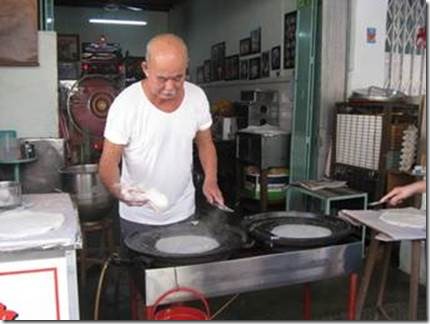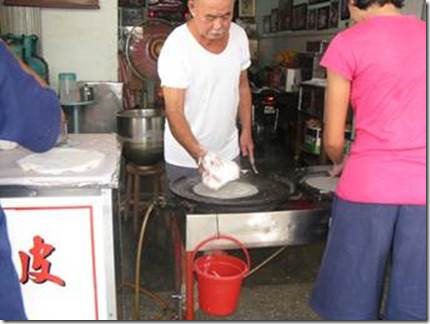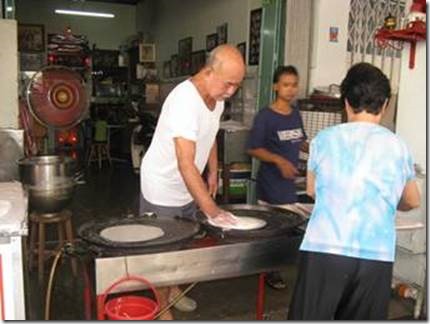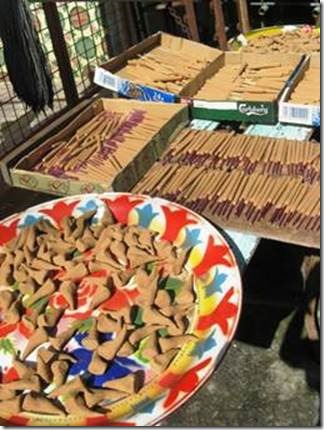Thanks in large part to Elizabeth being such a wonderful guide I was able to see many interesting bits of George Town in the very short time we were in Penang. ( I should also thank Patrick for parting with Elizabeth’s help for the day and Randal who always encourages me to see the sights while he tends to boat needs.) Please, Elizabeth, correct me where I go wrong or totally make things up!
Elizabeth and Ruth drink tea, eat chocolate and meet an artist.
Our second Friday at the boat yard, Elizabeth was able to take time to guide me around George Town. Randal decided to go along with us, not to sight see, but to get some boat supplies. That Friday, unbeknownst to us, was the first day of Hari Raya Qurban, a Malaysian Islamic national holiday so all museums, some retail shops, and even most Muslim restaurants were closed. That didn’t spoil Elizabeth’s and my day at all but Randal, who had just come for one specific shop went home early and mostly empty handed. For Elizabeth and me, the holiday closings created the opportunity for different adventures.
Our first stop in George Town always being a second breakfast, we headed to our favorite Muslim restaurant only to find it closed for the holiday. As we toured the streets to find another, we ran into our good friend Ian from Reeflections II. We had first met Ian and his wife Robin in Sebana Cove at a dockside happy hour. Robin is the nurse who took care of me when I had my bout of food poisoning. We reconnected with them in Singapore and at that time Ian was the hero for climbing our mast several times to fix our anchor light. They were now in the marina in George Town where Robin was recovering from knee surgery performed at the local hospital. We ate breakfast with Ian and afterwards he and Randal went off for boat stuff and Elizabeth and I went off to see George Town. Had there been no holiday, our favorite green and yellow restaurant would have been open and we might not have met Ian.
On our way to find breakfast we passed by a man making popiah on Chowrasta Road. He makes them from 8 to 11 on weekdays. Like most shops, this one opens out to the road so you can watch the work being done: an interesting way to advertise.
Step one
Step two
Step three
“Popiah in Hokkien dialect translates to Spring Roll. If you’ve ever wondered how spring roll wrap is made, then this is the place to watch and learn. The owner can make a minimum of 15 pieces of spring roll wrap per minute! For those who aren’t familiar with the history of popiah or spring rolls. This ever popular dish has its origins in Northern China sometime during the Qing Dynasty to celebrate the good harvest. The Chinese believe that the new year’s cycle begins with Spring when everything comes alive after the cold, harsh winter. The original spring roll filling was made mainly out of fresh vegetables collected from the year’s first harvest, sliced, cooked and wrapped in thin dough” http://www.journeymalaysia.com/MI_penang3.htm provided the info: the photos are mine.
When I had my art classes in Singapore, I had often gone for lunch at the Maxwell Food Court in Chinatown and always ate popiah. The stall didn’t make the wraps, but made the filling and the finished roll as I stood waiting. They were wonderful.
After breakfast Elizabeth took me to see the joss maker.
Some samples of joss
![]() This is a photo of Mr. Lee but it’s from the website, he hurried away just as we arrived. We did see a box of joss sticks just like he is making in this photo.
This is a photo of Mr. Lee but it’s from the website, he hurried away just as we arrived. We did see a box of joss sticks just like he is making in this photo.
Joss (Incense)
Unfortunately, when we got to his shop he only had time to tell us that he was off to see the doctor. But his story is really interesting.
“Mr. Lee Beng Chuan has been making joss sticks for decades now. This sprightly 60-some year old man and his wife continue to churn out joss sticks for a select group of loyal customers. Mr. Lee started out not as a joss stick maker but he was commissioned to handcraft dragon and phoenix effigies onto large joss sticks that were used for special occasions such as important Chinese festivals and birthdays. As his eyesight began to fail, he decided to switch to a labour intensive but less skilful career and hence making joss sticks instead. Today, Mr. and Mrs. Lee continue to churn out joss sticks for their very niche market. Although, Mr Lee used to produce thin jossticks – those often seen at alters in temples, he can no longer compete in pricing especially those from China and Vietnam. Instead, he makes shorter, fatter jossticks, which he says are more appropriate for his customers who many have moved away from houses and into apartments. In this way, the smaller jossticks would take a shorter time to burn and hence less smoke in the apartment.
Visitors can buy jossticks from Mr. Lee. He sells them in a variety of sizes. He will proudly show anyone interested, the process of making jossticks over and over again without missing a skip. However, Mr. Lee and wife speak only Chinese and a bit of Malay. On rainy days, Mr. Lee does other things apart from making jossticks, as the process requires quite a bit of sun. The final stages before packing is to dry the jossticks under direct sunlight for 2 days. Mr. Lee has lived in this house on this street for over 65years. He sadly reminisces days when the row of houses in which he still lives on were filled with folks working on all sorts of trades. As the younger generation went off to school and universities, they left their homes for luxuries of apartments and bigger cities. Many of the older generations went along and retired from their livelihood. Mr. Lee maintains that he and his wife would prefer to work for as long as they are able to ~ their way of life is what makes them whole.”
No. 1 Lorong Muda. Operations hours: 8.00am – 11.00am (also depending on the rain, weekdays).
http://www.journeymalaysia.com/MI_penang2.htm#5
We walked over near the Esplanade to catch the free bus that takes you around George Town.
I took this photo from the boat as we passed by on our way to Langkawi. You can see the style of the government buildings along the Esplanade built by the British during the 1800s and early 1900s
St George’s Church, dates from 1818 and is the oldest Anglican church in Malaysia.
According to http://www.tourismpenang.gov.my/heritage_st_georges_church.html it was built by Indian convicts. I think Elizabeth said it was being renovated. In any event we didn’t go in but waited just in front for the free bus that takes you around George Town.
Elizabeth looks at the map to plan our next stop…to find some art.
Drainage ditches ran along the sidewalks so you had to plot your way.
Lots of trishaws around but I would guess they are mostly for the tourists.
Not everything was famous but it was all lovely to look at.
Just wandering the small streets gives you lots to see.
While I was noticing the lovely tile and woodwork in front of this building, Elizabeth had noticed the inside which was a tea shop. We went in for tea and also found art.
I’ll tell you about it next email…..
Ru
DoraMac













